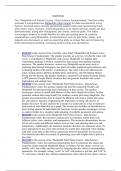Summary
Summary MATPLOTLIB IN PYTHON
- Course
- Institution
These comprehensive summary notes on Matplotlib offer a concise yet thorough overview of one of the most widely used libraries for data visualization in Python. Whether you're a beginner seeking to grasp the fundamentals or an intermediate user aiming to deepen your understanding, these notes provi...
[Show more]



